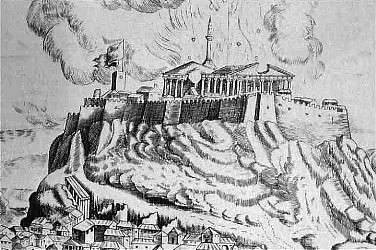The Pathenon & the Parthenon Marbles - Matt Barrett's perspective
The Parthenon or the Temple of Athena was built between 447 and 438 BC in the Doric style under the leadership of Pericles. The acropolis had been the site of an older temple and other monuments which had been destroyed by the Persians when the people of Athens evacuated the city. When the Persians were defeated columns from the older buildings were used in the construction of the Acropolis walls as a reminder of what Athens had suffered.
The Parthenon was designed by the architects Ictinos and Callicrates, built of local marble from Mount Pendeli and build by a large number of sculpturers, masons, painters and other craftsmen.
The columns of the Parthenon supported a marble beam to which were attached the metopes, high relief sculptures of different subjects on each side. The eastern side of the building was a battle between the Olympian Gods and the giants. On the west are the Greeks battling the Amazons. On the north the scenes seem to be from the fall of Troy. On the south are battles between men and the centaurs.
The triangle sections of the building were the pediments and contained about 50 large statues which were carved and then hoisted up. According to Pausanias, the east pediment showed the birth of Athena, the west showed the contest between Athena and Poseidon over who would rule Athens and Attika.
The statues were originally painted, but by the time western Europeans had arrived the paint was long gone and for many years they believed that this was their normal state. In fact the idea of the Greeks having painted their statues seemed almost like sacrilege to the Europeans.
The Parthenon frieze by Phideas went around the whole building was also carved in relief and is believed to show the sacrifice of the daughters of Erechtheus, one of the founding myths of Athens and the subject of a lost play by Euripides.
The main feature of the Parthenon was the giant statue of Athena which was inside and has since disappeared. There were several other buildings on the Acropolis. The propylaea was the entranceway. To the right was the small temple of Athena Nike and to the left was the Erechthion and the famous porch of the maidens.
The Parthenon and the other buildings of the Acropolis remained intact through the Roman conquests, when Athens was considered the cultural capital for the whole empire. The emperor Augustus built a small temple in front of the Parthenon and the Emperor Hadrian financed a building program said to be as ambitious as that of Pericles.
When the Emperor Constantine declared Christianity as the official religion of the empire in the fourth century Athens was considered pagan and in 529 the philosophy schools were closed, putting an end to the traditions of classical Athens.
When Alaric the Goth invaded the empire he spared Athens the plundering and devastation that other cities in his path had experienced. According to the legend, he took the sun flashing on the bronze shield of the statue of Athena as a sign from God.
In the 6th Century the Parthenon was converted to a Christian church and the east pediment torn down and many of its sculptures defaced. When the crusaders who destroyed Constantinople occupied Athens they began a period of western rule and the Parthenon became the Roman Catholic Church of Notre Dame. Finally during the Turkish occupation it was converted into a mosque and a minaret was built on the top. Except for the statue of Athena, the statues of the east pediment and the treasures and statues in the interior, the building was still completely intact.
That changed on September 26 1687 when the Parthenon, which was being used by the Turks as a gunpowder magazine after the previous facility, the Propelea had been destroyed when struck by lightning, was hit by a cannon from the Venetians who were laying siege to the Acropolis. The whole building exploded, the roof blown off, sections of columns blown down and many of the sculptures were destroyed.

Parthenon burning 1687
When the Turks surrendered, the Venetian general Morosini decided to take back to Venice the surviving sculptures from the west pediment but in the effort the cables broke and they all shattered. He left on the Acropolis the ruins of the Parthenon with piles of marble from the statues and the building which were taken and used as building material or ground into lime.
After the Venetians left more of the Parthenon was torn town to be used as building materials and even the lead core which held the columns together was extracted, melted down and used for bullets.
By the eighteenth century travelers from western Europe were buying sculpture which increased their value enough so they would not be used for lime. The Turks were happy to sell pieces of ancient buildings and statues though they could not understand why anyone would want them. These pieces made their way back to Europe. Most have disappeared but some of turned up in museums, private collections and in people's gardens.
Thank you to Matt Barrett, for permission to reprint Parthenon Marbles sections from his master web-site at
http://www.greecetravel.com/
This is also a very valuable site for traveller's/tourists to Greece.